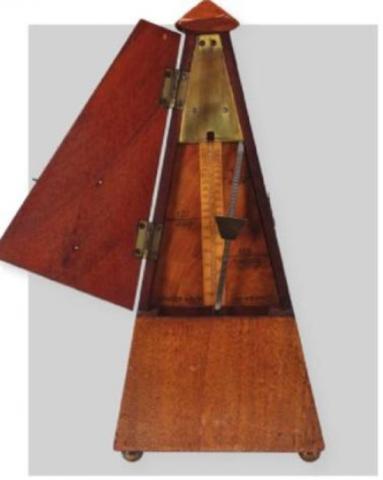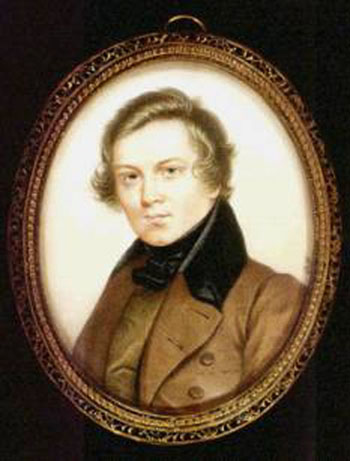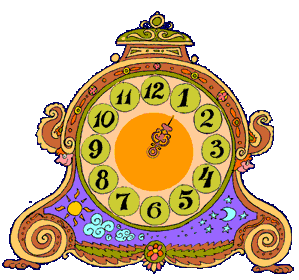"The history of music, supported by the actual hearing of
the master compositions of the different epochs, is the
shortest way to cure you of self-esteem and vanity."
AUTHOR: Robert Schumann
MEANING OF THE QUOTE:
"A person may think their art is great until
they compare it with the greatest masters
such as Beethoven and Mozart."
MEANING OF THE QUOTE:
"A person may think their art is great until
they compare it with the greatest masters
such as Beethoven and Mozart."
SYMPHONY NO. 101
in D MAJOR HOB. I:101
"The Clock" (1793-94)
Complete
"The Clock" (1793-94)
Complete
Charles Mackerras, Conductor
Orchestra of St. Luke's
Orchestra of St. Luke's
00:00 - Adagio - Presto
08:11 - Andante
15:43 - Menuet: Allegretto
22:29 - Vivace
Haydn was influenced to create
"The Clock Symphony" by the
new invention known as
 |
| https://www.awesomestories.com/ asset/view/Maelzel-Metronome |




ANOTHER EXAMPLE OF THIS SYMPHONY
PLAYED WITH SOME PERIOD-TYPE INSTRUMENTS
SYMPHONY NO. 101
in D MAJOR HOB. I:101
"The Clock" (1793-94)
Complete
Roger Norrington, Conductor
 |
| Paul-Cezanne: The Black Clock, 1870 |
SYMPHONY NO. 101
in D MAJOR HOB. I:101
"The Clock" (1793-94)
I. Adagio - Presto
Mogens Woldike, Conductor
Vienna State Opera Orchestra
In the "Clock," the first movement's
chromatically edgy slow D-minor
mode introduction is mysterious;
dark and hushed, but the suspense
quickly shifts to a change of key; a
light-footed presto principle theme
in six-eight time.
The secondary theme proves
to be more a variant than a
contrast; the development is
a surprisingly contrapuntal.
SYMPHONY NO. 101
in D MAJOR HOB. I:101
"The Clock" (1793-94)
II. Andante
Ferenc Fricsay, Conductor
RIAS Symphony Orchestra Berlin

It is the Andante (second movement)
that gives the Symphony its nickname.
The music begins with the famous
evocation of a ticking grandfather
clock created by pizzicato (plucked)
lower strings and a metronomic
staccato ostinato in the bassoons.
This is accompanied by a simple, but
charming, stately melody; a stormy
ferocious G-minor interlude in the
middle of the movement followed by
some harmonic jokes and finally
resolved by the "clock’s" return in
a quiet and courtly stability. Hearing
the sounds of the clocks the listener
can imagine a variety of different
types of clocks "ticking."
that gives the Symphony its nickname.
The music begins with the famous
evocation of a ticking grandfather
clock created by pizzicato (plucked)
lower strings and a metronomic
staccato ostinato in the bassoons.
This is accompanied by a simple, but
charming, stately melody; a stormy
ferocious G-minor interlude in the
middle of the movement followed by
some harmonic jokes and finally
resolved by the "clock’s" return in
a quiet and courtly stability. Hearing
the sounds of the clocks the listener
can imagine a variety of different
types of clocks "ticking."
.jpg) |
|
WHICH MAY HELP TO REMEMBER THE TUNE
(IN A DIFFERENT KEY THEN THE ORIGINAL
TO MAKE IT MORE VOICE FRIENDLY)
|

ORCHESTRAL COLOR GRAPH
OF MOVEMENT II
(Click to see enlarged)
 |
| http://www.orchestralrevolution.com/orchestral-graphs.php# |



SYMPHONY NO. 101
in D MAJOR HOB. I:101
"The Clock" (1793-94)
III. Menuet: Allegretto
Ferenc Fricsay, Conductor
RIAS Symphony Orchestra Berlin
| FIRST THEME |
The Minuet, with its use of
trumpets and drums, is lavish
with elaborate scoring and
contrapuntal effects; the
longest one Haydn wrote for
any of his symphonies. It has
a contrasting Trio section
emulating the sound of a
rustic band. This section is
gently pleasant but also slightly
comical as the music flow is
sometimes interrupted by what
sounds like some not-very-
talented village band musicians,
playing deliberate "wrong"
notes emphasized with
occassional musical outbursts.
trumpets and drums, is lavish
with elaborate scoring and
contrapuntal effects; the
longest one Haydn wrote for
any of his symphonies. It has
a contrasting Trio section
emulating the sound of a
rustic band. This section is
gently pleasant but also slightly
comical as the music flow is
sometimes interrupted by what
sounds like some not-very-
talented village band musicians,
playing deliberate "wrong"
notes emphasized with
occassional musical outbursts.
SYMPHONY NO. 101
in D MAJOR HOB. I:101
"The Clock" (1793-94)
IV. Vivace
Herbert von Karajan, Conductor
Berliner Philharmoniker
The finale, brilliant and
energetic Vivace, is an
extremely elaborate
sonata rondo which
is built from a few
remarkably simple
melodic ideas that
continue to evolve and
develop in a fugal format
 |
| Salvador Dali: Melting Clocks |
TO LISTEN TO A HISTORY AND ANALYSIS OF
THIS SYMPHONY CLICK ON THE LINK BELOW
http://www.bbc.co.uk/programmes/p01y2tmk
LINKS
THIS SYMPHONY CLICK ON THE LINK BELOW
http://www.bbc.co.uk/programmes/p01y2tmk







.jpg)
.jpg)
.jpg)
trio.jpg)
.jpg)
.jpg)

